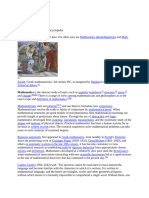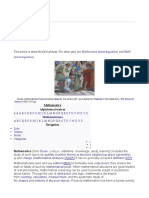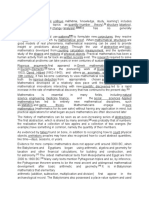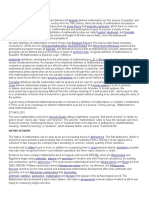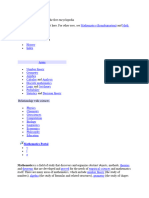0 ratings0% found this document useful (0 votes)
38 viewsMathematics: Mathematics (Disambiguation) Math (Disambiguation)
Mathematics is the study of topics such as quantity, structure, space, and change. It involves seeking patterns and using logic and abstraction. Mathematics has developed from counting, measurement, and the study of shapes and motions. It is used throughout the world in fields like science, engineering, and finance. Some key aspects of mathematics are its evolution over time, with important early developments in places like ancient Egypt, Babylon, and Greece; its foundations in logic and proof; and its growth into diverse fields like pure and applied mathematics.
Uploaded by
Vaibhav MohnotCopyright
© © All Rights Reserved
Available Formats
Download as DOCX, PDF, TXT or read online on Scribd
0 ratings0% found this document useful (0 votes)
38 viewsMathematics: Mathematics (Disambiguation) Math (Disambiguation)
Mathematics is the study of topics such as quantity, structure, space, and change. It involves seeking patterns and using logic and abstraction. Mathematics has developed from counting, measurement, and the study of shapes and motions. It is used throughout the world in fields like science, engineering, and finance. Some key aspects of mathematics are its evolution over time, with important early developments in places like ancient Egypt, Babylon, and Greece; its foundations in logic and proof; and its growth into diverse fields like pure and applied mathematics.
Uploaded by
Vaibhav MohnotCopyright
© © All Rights Reserved
Available Formats
Download as DOCX, PDF, TXT or read online on Scribd
You are on page 1/ 4
Mathematics
From Wikipedia, the free encyclopedia
This article is about the study of topics, such as quantity and structure. For other uses,
see Mathematics (disambiguation).
"Math" redirects here. For other uses, see Math (disambiguation).
Euclid (holding calipers), Greek mathematician, 3rd century BC, as imagined by Raphael in this detail fromThe
School of Athens.
[1]
Mathematics is the study of topics such
as quantity (numbers),
[2]
structure,
[3]
space,
[2]
and change.
[4][5][6]
There is a range of views among
mathematicians and philosophers as to the exact scope and definition of mathematics.
[7][8]
Mathematicians seek out patterns
[9][10]
and use them to formulate new conjectures. Mathematicians
resolve the truth or falsity of conjectures by mathematical proof. When mathematical structures are
good models of real phenomena, then mathematical reasoning can provide insight or predictions
about nature. Through the use of abstraction and logic, mathematics developed
from counting, calculation, measurement, and the systematic study of the shapes and motions of
physical objects. Practical mathematics has been a human activity for as far back as written
records exist. The research required to solve mathematical problems can take years or even
centuries of sustained inquiry.
Rigorous arguments first appeared in Greek mathematics, most notably in Euclid's Elements. Since
the pioneering work ofGiuseppe Peano (18581932), David Hilbert (18621943), and others on
axiomatic systems in the late 19th century, it has become customary to view mathematical research
as establishing truth by rigorous deduction from appropriately chosenaxioms and definitions.
Mathematics developed at a relatively slow pace until the Renaissance, when mathematical
innovations interacting with new scientific discoveries led to a rapid increase in the rate of
mathematical discovery that has continued to the present day.
[11]
Galileo Galilei (15641642) said, "The universe cannot be read until we have learned the language
and become familiar with the characters in which it is written. It is written in mathematical language,
and the letters are triangles, circles and other geometrical figures, without which means it is humanly
impossible to comprehend a single word. Without these, one is wandering about in a dark
labyrinth."
[12]
Carl Friedrich Gauss (17771855) referred to mathematics as "the Queen of the
Sciences".
[13]
Benjamin Peirce (18091880) called mathematics "the science that draws necessary
conclusions".
[14]
David Hilbert said of mathematics: "We are not speaking here of arbitrariness in any
sense. Mathematics is not like a game whose tasks are determined by arbitrarily stipulated rules.
Rather, it is a conceptual system possessing internal necessity that can only be so and by no means
otherwise."
[15]
Albert Einstein (18791955) stated that "as far as the laws of mathematics refer to
reality, they are not certain; and as far as they are certain, they do not refer to reality."
[16]
French
mathematician Claire Voisin states "There is creative drive in mathematics, it's all about movement
trying to express itself."
[17]
Mathematics is used throughout the world as an essential tool in many fields, including natural
science, engineering, medicine, finance and the social sciences.Applied mathematics, the branch of
mathematics concerned with application of mathematical knowledge to other fields, inspires and
makes use of new mathematical discoveries, which has led to the development of entirely new
mathematical disciplines, such as statistics and game theory. Mathematicians also engage in pure
mathematics, or mathematics for its own sake, without having any application in mind. There is no
clear line separating pure and applied mathematics, and practical applications for what began as
pure mathematics are often discovered.
[18]
Contents
1 History
o 1.1 Evolution
o 1.2 Etymology
2 Definitions of mathematics
3 Inspiration, pure and applied mathematics, and aesthetics
4 Notation, language, and rigor
5 Fields of mathematics
o 5.1 Foundations and philosophy
o 5.2 Pure mathematics
o 5.3 Applied mathematics
6 Mathematical awards
7 Mathematics as science
8 See also
9 Notes
10 References
11 Further reading
12 External links
History
Evolution
Main article: History of mathematics
Greek mathematicianPythagoras(c. 570 c. 495 BC), commonly credited with discovering the Pythagorean theorem
The evolution of mathematics might be seen as an ever-increasing series of abstractions, or
alternatively an expansion of subject matter. The first abstraction, which is shared by many
animals,
[19]
was probably that of numbers: the realization that a collection of two apples and a
collection of two oranges (for example) have something in common, namely quantity of their
members.
Mayan numerals
Evidenced by tallies found on bone, in addition to recognizing how to count physical
objects,prehistoric peoples may have also recognized how to count abstract quantities, like time
days, seasons, years.
[20]
More complex mathematics did not appear until around 3000 BC, when the Babylonians and
Egyptians began using arithmetic, algebra and geometry for taxation and other financial calculations,
for building and construction, and for astronomy.
[21]
The earliest uses of mathematics were
in trading, land measurement, painting and weaving patterns and the recording of time.
In Babylonian mathematics elementary arithmetic (addition, subtraction, multiplication anddivision)
first appears in the archaeological record. Numeracy pre-dated writing and numeral systems have
been many and diverse, with the first known written numerals created byEgyptians in Middle
Kingdom texts such as the Rhind Mathematical Papyrus.
[citation needed]
Between 600 and 300 BC the Ancient Greeks began a systematic study of mathematics in its own
right with Greek mathematics.
[22]
Mathematics has since been greatly extended, and there has been a fruitful interaction between
mathematics and science, to the benefit of both. Mathematical discoveries continue to be made
today. According to Mikhail B. Sevryuk, in the January 2006 issue of the Bulletin of the American
Mathematical Society, "The number of papers and books included in the Mathematical
Reviews database since 1940 (the first year of operation of MR) is now more than 1.9 million, and
more than 75 thousand items are added to the database each year. The overwhelming majority of
works in this ocean contain new mathematical theorems and theirproofs."
[23]
Etymology
The word mathematics comes from the Greek (mthma), which, in the ancient Greek
language, means "that which is learnt",
[24]
"what one gets to know", hence also "study" and "science",
and in modern Greek just "lesson". The word mthma is derived from (manthano), while
the modern Greek equivalent is (mathaino), both of which mean "to learn". In Greece, the
word for "mathematics" came to have the narrower and more technical meaning "mathematical
study" even in Classical times.
[25]
Its adjective is (mathmatiks), meaning "related to
learning" or "studious", which likewise further came to mean "mathematical". In
particular, (mathmatik tkhn), Latin: ars mathematica, meant "the
mathematical art".
In Latin, and in English until around 1700, the term mathematics more commonly meant "astrology"
(or sometimes "astronomy") rather than "mathematics"; the meaning gradually changed to its
present one from about 1500 to 1800. This has resulted in several mistranslations: a particularly
notorious one is Saint Augustine's warning that Christians should beware of mathematici meaning
astrologers, which is sometimes mistranslated as a condemnation of mathematicians.
[26]
The apparent plural form in English, like the French plural form les mathmatiques (and the less
commonly used singular derivative la mathmatique), goes back to the Latin neuter
plural mathematica (Cicero), based on the Greek plural (ta mathmatik), used
by Aristotle (384322 BC), and meaning roughly "all things mathematical"; although it is plausible
that English borrowed only the adjective mathematic(al) and formed the noun mathematics anew,
after the pattern ofphysics and metaphysics, which were inherited from the Greek.
[27]
In English, the
noun mathematics takes singular verb forms. It is often shortened to maths or, in English-speaking
North America, math.
[28]
You might also like
- Mathematics: This Article Is About The Field of Study. For Other Uses, See andNo ratings yetMathematics: This Article Is About The Field of Study. For Other Uses, See and6 pages
- Mathematics (from Greek: μάθημα, máthēma, 'knowledge, study, learning') includesNo ratings yetMathematics (from Greek: μάθημα, máthēma, 'knowledge, study, learning') includes2 pages
- Mathematics: Mathematics (Disambiguation) Math (Disambiguation)No ratings yetMathematics: Mathematics (Disambiguation) Math (Disambiguation)2 pages
- Mathematics (Disambiguation) Math (Disambiguation)No ratings yetMathematics (Disambiguation) Math (Disambiguation)1 page
- Mathematics: Jump To Navigation Jump To SearchNo ratings yetMathematics: Jump To Navigation Jump To Search9 pages
- Mathematics: Mathematics (Disambiguation) Math (Disambiguation)No ratings yetMathematics: Mathematics (Disambiguation) Math (Disambiguation)2 pages
- Mathematics: Jump To Navigationjump To SearchNo ratings yetMathematics: Jump To Navigationjump To Search4 pages
- Mathematics (from Greek μάθημα máthēma, "knowledge, study, learning")No ratings yetMathematics (from Greek μάθημα máthēma, "knowledge, study, learning")2 pages
- Prehistoric Mathematics: Plimpton 322 Rhind Mathematical Papyrus Moscow Mathematical PapyrusNo ratings yetPrehistoric Mathematics: Plimpton 322 Rhind Mathematical Papyrus Moscow Mathematical Papyrus3 pages
- Efinitions of Mathematics: BibliographyNo ratings yetEfinitions of Mathematics: Bibliography13 pages
- Mathematics (from Greek: μάθημα, máthēma, 'knowledge, study, learning') includesNo ratings yetMathematics (from Greek: μάθημα, máthēma, 'knowledge, study, learning') includes1 page
- Number Theory: Number Theory (Or Arithmetic or Higher Arithmetic in OlderNo ratings yetNumber Theory: Number Theory (Or Arithmetic or Higher Arithmetic in Older22 pages
- Who Invented Math and When?: Students Have A Complicated Relationship With MathematicsNo ratings yetWho Invented Math and When?: Students Have A Complicated Relationship With Mathematics6 pages
- Set Theory and Logic: University of ZimbabweNo ratings yetSet Theory and Logic: University of Zimbabwe78 pages
- (BETA) (SMA Selections 2021-22) Round 2 Details: Beta - The Finance and Investments Club of IIMANo ratings yet(BETA) (SMA Selections 2021-22) Round 2 Details: Beta - The Finance and Investments Club of IIMA2 pages
- Knowledge, Initiative & Talent Excellence Series Is ITC's Summer Internship ProgrammeNo ratings yetKnowledge, Initiative & Talent Excellence Series Is ITC's Summer Internship Programme1 page
- PG Brainstormer - 6c (Mechanics) 635453980676456802No ratings yetPG Brainstormer - 6c (Mechanics) 6354539806764568024 pages
- Statistics and Probability (Topic 5) RevisionNo ratings yetStatistics and Probability (Topic 5) Revision4 pages
- Midterm Examination: Fundamentals of MathematicsNo ratings yetMidterm Examination: Fundamentals of Mathematics6 pages
- FALLSEM2018-19 - MAT5009 - TH - TT531 - VL2018191004951 - Reference Material I - 01 - MAT 5009 - ADVANCED COMPUTER ARITHMETIC PDFNo ratings yetFALLSEM2018-19 - MAT5009 - TH - TT531 - VL2018191004951 - Reference Material I - 01 - MAT 5009 - ADVANCED COMPUTER ARITHMETIC PDF13 pages
- Simple Linear Regression: Definition of TermsNo ratings yetSimple Linear Regression: Definition of Terms13 pages
- Using GW-BASIC For Drawing Mandelbrot SetsNo ratings yetUsing GW-BASIC For Drawing Mandelbrot Sets3 pages
- 35 International Chemistry Olympiad: Athens, Greece Theoretical Examination Thursday, 10 July 2003No ratings yet35 International Chemistry Olympiad: Athens, Greece Theoretical Examination Thursday, 10 July 200330 pages
- Weekly Learning Activity Sheets Proving Triangle Congruence: Take NoteNo ratings yetWeekly Learning Activity Sheets Proving Triangle Congruence: Take Note6 pages
- Algorithm Design by Kleinberg and Tardos The Art of Computer Programming by Donald Knuth How To Solve It by Computer by R. G. DromeyNo ratings yetAlgorithm Design by Kleinberg and Tardos The Art of Computer Programming by Donald Knuth How To Solve It by Computer by R. G. Dromey2 pages
- Tutorial: Good Practice in Well Ties: First Break October 2003No ratings yetTutorial: Good Practice in Well Ties: First Break October 200327 pages
- Bio-Data (DR.P.K.sharMA) As On 13th June 2023No ratings yetBio-Data (DR.P.K.sharMA) As On 13th June 202334 pages
- Quine: Perspectives On Logic, Science and Philosophy: Interview by Bradley Edmister and Michael OjsheaNo ratings yetQuine: Perspectives On Logic, Science and Philosophy: Interview by Bradley Edmister and Michael Ojshea11 pages
- AMC2019 StudentsResults-Indonesia-9 & 10 INo ratings yetAMC2019 StudentsResults-Indonesia-9 & 10 I3 pages
- TAFL Theory (Theory Unit-1 To Unit - 5)No ratings yetTAFL Theory (Theory Unit-1 To Unit - 5)10 pages
- Applied Acoustics: Masoud Golzari, Ali Asghar JafariNo ratings yetApplied Acoustics: Masoud Golzari, Ali Asghar Jafari22 pages
- FEMSSISA-Grade-7-Mathematics-Olympiads-2024No ratings yetFEMSSISA-Grade-7-Mathematics-Olympiads-20246 pages
- Tutorial - Unit-I - Partial DifferentiationNo ratings yetTutorial - Unit-I - Partial Differentiation4 pages
- Mathematics: This Article Is About The Field of Study. For Other Uses, See andMathematics: This Article Is About The Field of Study. For Other Uses, See and
- Mathematics (from Greek: μάθημα, máthēma, 'knowledge, study, learning') includesMathematics (from Greek: μάθημα, máthēma, 'knowledge, study, learning') includes
- Mathematics: Mathematics (Disambiguation) Math (Disambiguation)Mathematics: Mathematics (Disambiguation) Math (Disambiguation)
- Mathematics (Disambiguation) Math (Disambiguation)Mathematics (Disambiguation) Math (Disambiguation)
- Mathematics: Mathematics (Disambiguation) Math (Disambiguation)Mathematics: Mathematics (Disambiguation) Math (Disambiguation)
- Mathematics (from Greek μάθημα máthēma, "knowledge, study, learning")Mathematics (from Greek μάθημα máthēma, "knowledge, study, learning")
- Prehistoric Mathematics: Plimpton 322 Rhind Mathematical Papyrus Moscow Mathematical PapyrusPrehistoric Mathematics: Plimpton 322 Rhind Mathematical Papyrus Moscow Mathematical Papyrus
- Mathematics (from Greek: μάθημα, máthēma, 'knowledge, study, learning') includesMathematics (from Greek: μάθημα, máthēma, 'knowledge, study, learning') includes
- Number Theory: Number Theory (Or Arithmetic or Higher Arithmetic in OlderNumber Theory: Number Theory (Or Arithmetic or Higher Arithmetic in Older
- Who Invented Math and When?: Students Have A Complicated Relationship With MathematicsWho Invented Math and When?: Students Have A Complicated Relationship With Mathematics
- Mathematics: Sound smarter without trying harderFrom EverandMathematics: Sound smarter without trying harder
- (BETA) (SMA Selections 2021-22) Round 2 Details: Beta - The Finance and Investments Club of IIMA(BETA) (SMA Selections 2021-22) Round 2 Details: Beta - The Finance and Investments Club of IIMA
- Knowledge, Initiative & Talent Excellence Series Is ITC's Summer Internship ProgrammeKnowledge, Initiative & Talent Excellence Series Is ITC's Summer Internship Programme
- PG Brainstormer - 6c (Mechanics) 635453980676456802PG Brainstormer - 6c (Mechanics) 635453980676456802
- FALLSEM2018-19 - MAT5009 - TH - TT531 - VL2018191004951 - Reference Material I - 01 - MAT 5009 - ADVANCED COMPUTER ARITHMETIC PDFFALLSEM2018-19 - MAT5009 - TH - TT531 - VL2018191004951 - Reference Material I - 01 - MAT 5009 - ADVANCED COMPUTER ARITHMETIC PDF
- 35 International Chemistry Olympiad: Athens, Greece Theoretical Examination Thursday, 10 July 200335 International Chemistry Olympiad: Athens, Greece Theoretical Examination Thursday, 10 July 2003
- Weekly Learning Activity Sheets Proving Triangle Congruence: Take NoteWeekly Learning Activity Sheets Proving Triangle Congruence: Take Note
- Algorithm Design by Kleinberg and Tardos The Art of Computer Programming by Donald Knuth How To Solve It by Computer by R. G. DromeyAlgorithm Design by Kleinberg and Tardos The Art of Computer Programming by Donald Knuth How To Solve It by Computer by R. G. Dromey
- Tutorial: Good Practice in Well Ties: First Break October 2003Tutorial: Good Practice in Well Ties: First Break October 2003
- Quine: Perspectives On Logic, Science and Philosophy: Interview by Bradley Edmister and Michael OjsheaQuine: Perspectives On Logic, Science and Philosophy: Interview by Bradley Edmister and Michael Ojshea
- Applied Acoustics: Masoud Golzari, Ali Asghar JafariApplied Acoustics: Masoud Golzari, Ali Asghar Jafari

